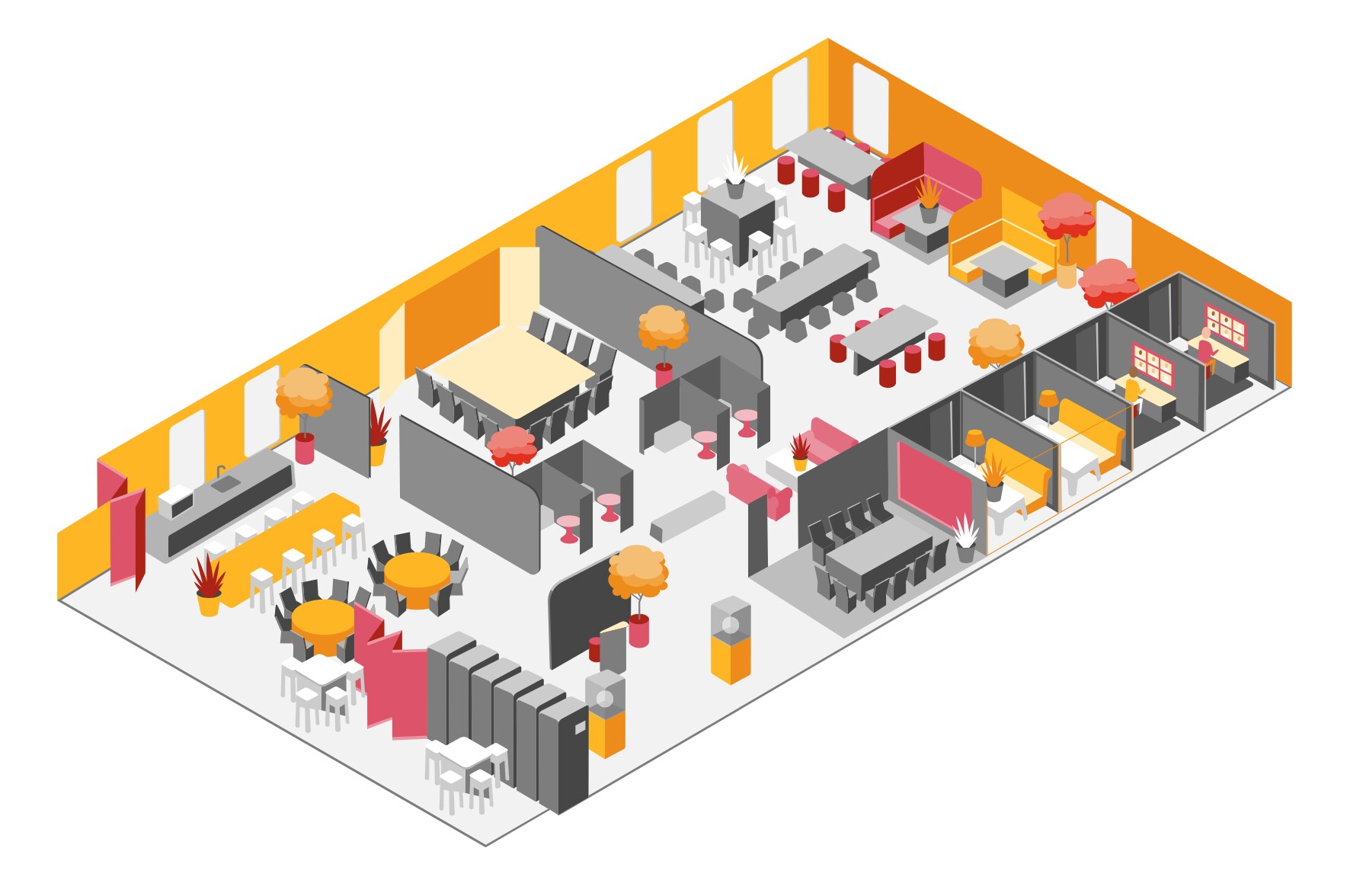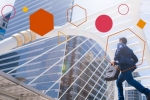
There aren’t many things Australia’s employees have enjoyed during the extended periods of lockdown. But the choice and flexibility remote hybrid work has brought with it is something we want to keep.
However, if work has changed forever, what does that mean for our workplaces? And what should your office look like if you want to realise the very real opportunities a future of hybrid work presents?
-%
of Australian workers say changing attitudes to remote working and benefits will transform the way people work over the next three to five years1
-%
want a mix of remote and in-person working2
-%
of workers say they would consider quitting if they were forced to abandon remote work completely3
The potential impact of sticking with traditional workplace models is enormous. Ignoring employee expectations could cost businesses talent at a time when the majority of Australia’s CEOs (60%) want to increase headcount.4 The office will continue to be an important hub for collaboration, with nine in ten people (91%) seeing the office as a desirable place to work.5 But it won’t be the only place.
As we look to the future, many organisations now envision a hybrid work model that combines three spaces:
Home
Office
Third space
Think: cafe, library, co-working space
1 ‘Changing Places: How hybrid working is rewriting the rule book’, PwC Australia
2 ‘Upskilling hopes and fears’, Australian data; In the future, what would your ideal work environment look like?, PwC, 2021
3 LiveCareer research, reported ‘Go back to the office? Some employees would rather quit’, TechRepublic, January 18 2021
4 ‘Building resilience: from reactive to proactive, PwC Australia’s 24th CEO Survey, 2021.
5 How to structure the workplace after COVID-19, Hassel, June 2021
That makes it critical to get your office workspace right. But selecting the right workplace model for a given organisation involves a complicated set of trade-offs between flexibility and structure, real estate and culture.
Responding to the needs of a flexible workforce and the role of the office to facilitate collaboration and socialisation, the office as we know it is changing.
It no longer needs to accommodate assigned desks or be seen only as a ‘9am-5pm’ space. Different teams will have their own work styles, patterns and preferences and companies will need to redesign office spaces to suit that, while enabling culture and strengthening organisational purpose.
The office of the future will be different. It will no longer accommodate all activities associated with work, but provide a place for those tasks that cannot successfully be done at home. In order to successfully evolve and embrace hybrid working, businesses will need to consider the four C’s:
Concentration:
Solo work, focus
Collaboration:
Brainstorming, teamwork
Communication:
Training, socialising
Contemplation:
Reflecting, relaxing
This framework is critical in moving forward. Businesses will need to find a balance between offering too much or too little of each space type. The focus should be on creating an equitable working experience, whether employees are participating in-person or remotely.
Future workplaces will be where people, technology, and processes can integrate seamlessly to enable highly productive work. It will be a place of instant and seamless flow between the physical and virtual workplaces. A digitally enabled workplace is now a necessity, not a ‘perk’.
To help organisations take the next step, we’ve worked with international design firm Hassell to explore what a fit-for-the-future workplace could look like for two people, Dev and Jenny.
Their stories let us look at two models of work - Activity based working (ABW), taking the collaborative design approach, and Clubhouse, drawing on the idea that employees want to feel a sense of belonging.
Meet Dev and Jenny
Since the pandemic, Jenny and Dev have been working from home with varying levels of success.
Dev’s team agreed that they lost some of their creative spark and the ability to rapidly respond.
Jenny had the opposite experience, finding her productivity skyrocketed.
After employee consultation revealed that the strength of the organisation, the culture and the workstyle rely on people coming together face-to-face to rapidly problem-solve, Dev’s company chose to adopt the Turbocharged ABW model to support this.
Whereas for Jenny, given the great results and the appetite for working differently, the business decided to adopt the Clubhouse model for their workspace.
Turbocharged ABW: An office‑centric work model
Supporting the Turbocharged ABW model, the new office looks and feels somewhat like the pre-COVID office, but there are also some pronounced differences.
ABW allows employees to choose from a variety of spaces according to the nature of their work. In this model, employees divide their time relatively equally between home and office.
Roche, Sydney. Design by Hassell. Photography by Nicole England.
GSK Asia House, Singapore. Design by Hassell. Photography by Peter Bennetts.
Transurban, Melbourne. Design by Hassell. Photography by Tom Blanchford.
Hassell studio, Sydney. Design by Hassell. Photography by Nicole England.
Mixed mode: The new open office

Connect
Arrive, transition, catch up and enjoy food and drinks. The social heart
Did you know?
More than 80% of companies are embracing a hybrid model whereby employees are in the office three days a week, according to a survey by KayoCloud, a real estate technology platform.
Here Come Hot Desks and Zoom Rooms. And Holograms?, New York Times, March 2021
Plan ahead
Understanding what shape your peak occupancy takes, and ensuing you have the right amount of space to enable it, is critical to getting your hybrid workplace right. The best plans are data-driven; start capturing your occupancy data using simple, off-the-shelf sensors or security swipe data analysed weekly.
Did you know?
Research suggests that the Turbocharged ABW model and the Clubhouse model are the most desirable options for Australian offices.
How to Structure the Workplace After Covid, Hassell, April 2021Did you know?
For people working in the office, there is a very strong correlation between the quality of the work environment and the individual's performance. For people working at home, the correlation between their work environment and performance isn't as strong, but it’s still there.
The Workplace Beyond 2020, Hassell, November 2020When Dev arrives to work, he walks past the reception – an area within the ‘connect zone’ where the business presents creative imagery and data, bringing its purpose to life. He then makes his way past the help desk, where employees can get services like tech support and towards his locker.
Dev opens his locker using a facial recognition scanner that’s integrated into the company’s inhouse app. His building got rid of access passes for hygiene concerns after COVID-19.
A space without assigned desks
With fewer employees commuting to work every day, not everyone needs to have an assigned desk. There are now specially-designed spaces for other activities, such as collaboration, socialising and high focus work.
Dev enjoys coming into the office three days a week to focus on planning events and campaigns, catching up with teams and clients, taking part in creative brainstorms, and meeting with creative agencies.
He moves around the office throughout the day depending on the work he needs to do and the people he needs to spend time with. If needed, his team can also be assigned a bank of desks in the co-work zone where they work together.
This month, Dev and the team are working on an upcoming campaign launch. They prefer to meet at the office due to the technology and resources available and the collaborative environment.
Digital wayfinding tools such as touchless buttons to enter rooms, and the business’ apps and digital displays showcase office space availability and what events, meetings or social gatherings are on. The tools help Dev, his colleagues and visitors make the most of being in the office and feel connected.
Into the war room
With a big campaign launch coming up, Dev needs to brainstorm with colleagues in different locations as well as those in the office - so he heads to the war room.
The technology in the room makes it easy to look up samples, banners and posters. The large screens, and surround sound helps those who are physically in the meeting and those at home to have an equally good experience.
Knowledge sharing tools and immersive experience technology such as digital whiteboards support visual thinking and collaboration.
Food as glue
The office social space gets used all day. During the day, it’s a trendy cafe for celebratory morning teas and team-building activities. Food plays a big part, with lunch options provided for free by the company each day.
In the evenings, it transforms into a bar, with lower lighting, neon signage and music to create a place for employees to linger after work and for clients and industry collaborators to share a drink and chat.
Time to concentrate
With much of the office re-imagined to encourage collaboration, creativity and connection, it’s still important to have spaces where employees can concentrate.
In the high focus room, Dev takes advantage of soundproofing to tune out the buzz of the office. Greenery makes for a relaxing environment to get in the zone.
His company relies on space utilisation tools to collect data that shows how these spaces are being used, guiding decisions about how the space can be best set up to support employees.
Turbocharged ABW in focus
Highs
A smaller office footprint reduces real estate costs and allows investment in tech.
Employees enjoy flexibility in where they work.
Accommodates many different work styles. By beginning to analyse your office needs now you can define the purpose of your space to maximise its value.
Spaces can be unique, specific, and driven by brand.
Challenges
ABW requires cultural transformation and reskilling people to work in new ways.
The employee experience could be varied, with some rarely coming into the office.
Combining in-person and virtual work is more challenging than doing one or the other.
The Clubhouse: A remote‑centric flexibility model
ANZ Campus, Melbourne. Design by Hassell. Photography by Nicole England.
Sky Central, London. Design by Hassell. Photography by Mark Cocksedge.
Hassell studio, Sydney. Design by Hassell. Photography by Nicole England.
The Great Room, Singapore. Design by Hassell. Photography by EK Yap.
Despite working remotely, Jenny felt more connected to her colleagues and closer to work than ever before, and it showed in the team’s results. They exceeded their targets for launching new features and are improving the app quicker than pre-COVID.
Given the great results and the appetite for working differently, the business has decided to adopt the Clubhouse model for their workspace.
People mostly work at home or another space and get together in person at the office for special events, meetings and tasks that can’t easily be done at home.
The Clubhouse offers employees a comfortable and distinct alternative to their home work environments and a place to collaborate and strengthen bonds between otherwise dispersed team members. The space is designed to inspire and build culture, connection and social capital.
Mixed mode: The new open office

Connect
Arrive, transition, catch up and enjoy food and drinks. The social heart
A dearth of desks
Even before the pandemic, organisations reported that up to 50% of their assigned desks were unoccupied on any given day.
Like the ABW model, the removal of desks has made way for a variety of spaces for people to work and collaborate. In the Clubhouse model there are even fewer desk areas.
How to structure the workplace after COVID-19, Hassell, June 2021
Jenny’s work begins at home
Jenny works from home on most days and likes to head into the office for meetings that involve collaboration, training junior staff and testing new software as well as events and social gatherings.
She starts Monday and Friday with the kids, getting them ready for school and dropping them off. On the other days, Dev takes them to school while Jenny attends to early morning meetings with international colleagues. The workday usually begins with a virtual stand-up where the team catches up and shares their to-do lists for the week.
Showcase, share, brainstorm
Everyone in Jenny’s team that’s local tries to go into the office at least once a week to connect, socialise and collaborate on projects.
As they arrive, the office host - a common feature of the Clubhouse office model - creates a sense of being looked after in a personalised and friendly way.
With new spaces, including studio-style project and immersive display zones, the team find the re-designed office space helpful for showcasing work, talking through challenges they’ve experienced during the week and brainstorming innovations for the next release.
A place to gather and learn
At its heart is a large town hall presentation area and a breakaway courtyard where people can gather and learn from each other or step outside for some fresh air. The office feels more like an event or exhibition space - one that can also be used for client meetings and collaborations.
As a result, Jenny and her co-workers are now more likely than before to attend team and company events to which clients are often also invited.
Beyond buildings
Wellness features prominently in the Clubhouse model. Jenny’s company has supercharged its social spaces, offering a cafe with its own barista, and a bar. The workspace is rapidly becoming a social hub – where employees, clients, and the community meet, collaborate and connect with the company’s identity and purpose.
In addition to the office space, Jenny and her co-workers are also given access to a nearby gym, yoga classes, mental health support, childcare, resilience training and are provided with complimentary meals to share with colleagues when in the office.
Specialised spaces
With Wednesday also set aside for meetings with stakeholders to carry out user experience testing and refining digital interfaces, Jenny uses an integrated calendar coordination tool and meeting room booking system to ensure she can access the specialised spaces and people when she needs them.
The user experience lab is a sophisticated space which features technology that allows Jenny and her team to directly engage with people who use their app.
Jenny will often stay behind for an hour at the end of the work day to grab a wine with co-workers or clients before heading home.
During city wide events like the Comedy or Writers’ Festivals, Jenny loves how the venue opens up to the broader community as a venue for some of her favourite creators and entertainers.
Clubhouse in focus
Highs
Plays to the home and office’s strengths: focused work is often more manageable away from the the office and collaborative work tends to be better in-person.
The office becomes hyper-focused on delivering great amenities and experiences to employees, clients, and guests.
A smaller office footprint reduces real estate costs (but need to be reinvested into higher fit-out and running costs that come with guaranteeing an elevated, seamless hybrid experience including technology.)
Challenges
People’s schedules are not always evenly divided into collaborative and focused work.
It’s not tried and tested – while companies have experimented with the clubhouse model, few have adopted it as a wholesale replacement for a traditional office.
Can create operational complexities and expense.
Dev and Jenny debrief on their day
I’m really enjoying the flexibility that work now allows.
I agree. But I’ve also missed the work environment.
Yes, I think it’s better for you to work from the office. But for me, one or two days is great.
Being in office and collaborating with the team has helped me be more creative and we’re solving problems so much quicker.
That’s great! Hey, I’ve been meaning to ask. Have you heard of the Host concept?
No, what’s that?
As part of the revamp, we've introduced a Host who welcomes us into the office. It's helped everyone feel more connected with the business - and valued.
That’s really interesting! It's great that our organisations have put their people’s needs and wellbeing at the centre of our new workplaces. And that we’re seeing it pay off in productivity.
Getting it right for your organisation.
Selecting the ideal workplace model involves a set of compromises between flexibility and structure, real estate and culture. There’s no one-size-fits-all solution.
And while top-down leadership may be effective in times of crisis, it won’t cut it moving forward. Organisations must adapt to suit their business and employee needs and engage their people to understand their experiences and expectations.
Workplace design should consider:
leaders’ and individuals’ needs
the nature and style of the work
organisational culture and values
organisational purpose and goals.
While the office will be unique to your needs, visiting other spaces to get inspiration is highly recommended. The value of experimentation, including piloting changes to workspaces, cannot be underestimated.
Work environments designed with the user at the forefront can welcome, support, and engage employees like never before. By doing away with industrial approaches to productivity, organisations can turn office spaces into hubs for collaboration, connection and creativity.
Take the next step
Now is the time to act and make strategic decisions about the role and design of your workplace. To find out how we can help you create effective solutions for your workplaces and spaces contact our Future of Work leaders below.
The other option to consider is the Workplace Readiness Sprint, created by PwC in partnership with international design firm Hassell. The program evaluates current work experience to provide insights and data to create a workplaces roadmap and recommendations suitable to your business and employees.
Introducing change and knowing where to start to make the most of this new reality can be challenging. But there are clear steps that organisations and their leaders can take to make sure they’re heading in the right direction and creating lasting positive change.
Discover how to design a future fit solution that works, today.
Special thanks to Hassell for their instrumental contribution. Hassell are an award-winning design practice whose vision is to design places people love.
Get in touch with Evodia Alaterou, Principal at Hassell for more information.












